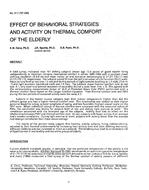Severe winter and summer weather, combined with energy prices seemingly spiraling out of control, have caused people in both the private and public sectors to consider combined heat and power (CHP). These systems, combining on-site generation of electricity with heat recovery for space heating, potable hot water, or indirect-fired absorption chillers for air conditioning, can result in significant cost and energy savings. Organizations in different branches of the U.S. government are at various stages in the design and installation of CHP projects. The Federal Energy Management Program (FEMP) is working with three of these organizations and their private sector partners to document CHP energy savings through pre-and post-retrofit monitoring of system operation and energy use and through computer modeling with typical year hourly weather data. Documentation of these success stories is expected to provide compelling arguments for other federal agencies to install CHP systems.
Sufficient pre-retrofit data have been collected at one site (the 82nd Heating and Cooling Steam Plant at Fort Bragg, North Carolina) to perform an analysis and project possible fuel use and electrical production. One configuration of equipment is considered–three 3.5 MW gas turbines with heat recovery steam generators and a supplemental boiler for peak loading–and compared with the existing gas-fired steam boiler plant. Turbine operation is controlled to meet the distri-bution system thermal loads, while electricity produced offsets purchases that would be made from the local utility. It is projected that one gas turbine would operate continuously, a second would operate at full load 92% of the time and at part load 8% of the time, and that the third would operate at full-load 54% of the time and at part load 38% of the time and would be idle 8% of the time. Gas turbine operation would provide 495.2 (469,700 x 10 6 Btu) of the 583.5 TJ (553,400 x 10 6 Btu) annual thermal load while producing 86,490 MWh of electricity; natural gas use increases from 748 TJ (7.10 x 10 6 therms) using the steam boilers to 1210 TJ (11.5 x 10 6 therms) for the turbines and supplemental boiler.
Estimated reductions in energy costs are heavily dependent on the relative costs of electricity and natural gas. On-site generation avoids purchases of approximately $2.5 million of electricity based on the average real time prices for 1998 through 2000. The net difference in costs for natural gas between the existing boiler plant and the proposed gas turbine plant is about $1.61 million. Savings in energy costs would be approximately $890,000 per year using average 1999 natural gas rates for industrial customers in North Carolina (EIA 2001).
Units: Dual
Citation: Symposium Papers, Atlantic City, 2002
Product Details
- Published:
- 2002
- Number of Pages:
- 7
- File Size:
- 1 file , 860 KB
- Product Code(s):
- D-7038


